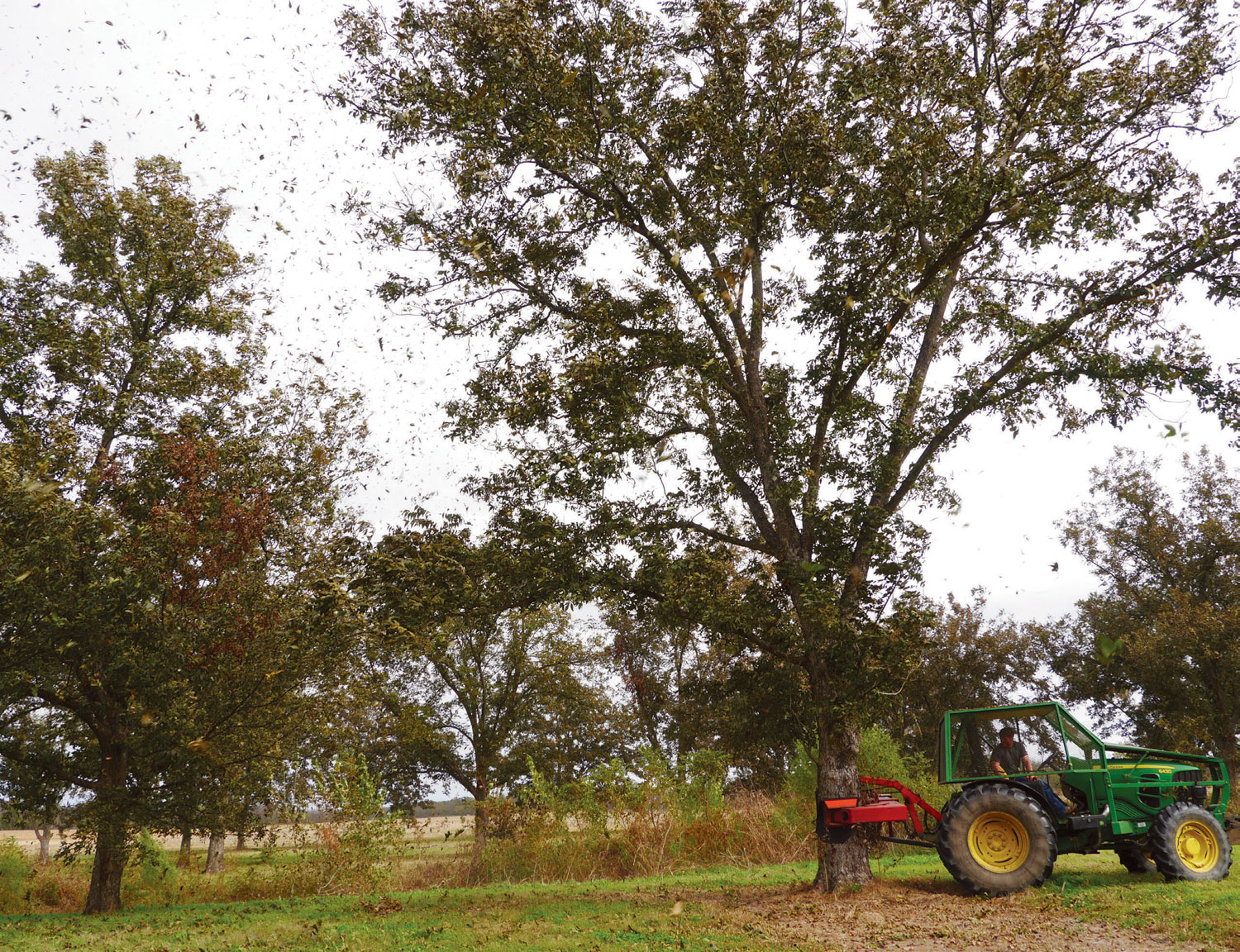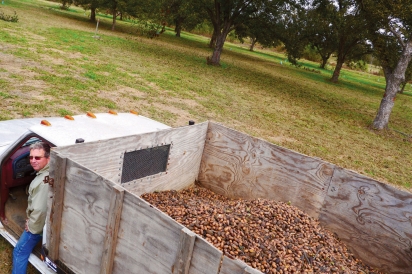Oklahoma Weather and Pecan Production
SOMETIMES IT’S NOT ALL IT’S CRACKED UP TO BE
Just southwest of Tulsa along Polecat Creek is a not-so-little plot of flat bottomland that stretches across hundreds of lush, green acres. It is here that we find Knight Creek Farms, a family-owned and -operated native pecan grove that’s been supplying nuts to Creek County since 1986.
Today, they maintain around 280 acres, and over 3,000 pecan trees. A seasonal shop near Tulsa Hills welcomes hungry guests in the fall and early winter months; throughout the rest of the year you can find their offerings at famers’ markets around town. I met with owner Bob Knight over coffee and was (naively) stunned to learn of the intricacies of large-scale pecan harvesting. There’s a ton that goes into the year-round process: Planting, irrigating, spraying, shaking, cleaning and sacking are just a few of the necessary tasks, and Bob, along with his son and the rest of the Knight Creek Farms team, handles all of it on site, soup to nuts. But what happens when the harvesting becomes more soupy than nutty? For those of you reading this who think I’m just nuttin’ out over here, let me be more specific: water. What happens to the pecan harvest when we get too much of it? In places like Oklahoma and Texas, which lead the country in pecan production, the question is a daunting one.
While Mother Nature’s twisted sense of humor had most of us momentarily grateful for some much-needed rainfall back in April, it’s safe to say that that sentiment is long gone. Oklahoma and Texas’ recent downpours have left more than families, homes and weekend plans in disrepair. Now there’s worry that Oklahoma’s crop harvest might be in deep water, too. With a record 14.18 inches of rainfall in May alone (Oklahoma’s wettest single month since 1941) and 14.77 inches for Tulsa, too much rain could have serious implications for this year’s crops, including pecan trees, which thrive in warm, dry climates— hence their proliferation in the Southwest.
For centuries, pecan trees have been known to triumph in times of intense environmental duress. They stand up through both dry and windy weather, withstand hail and rain exceptionally and hold up well in riverbed soils. But even the most rugged of plant life has a tipping point. And at a time when the amount of standing water is encroaching on the amount of land, preserving nut and vegetable harvests is becoming trickier by the week.
“The good thing about the rain is that it washes the pollen out of the air for people with pollen allergies,” Bob said. “But the bad thing about is that it washes the pollen out of the air, which is bad for the people who are pollinating their trees. Or anything else right now.”
Pollen is that nasty yellow-green film you see gathering on your car hood and porch swing come April, and the itchy-eyed venom that sends allergic folks into a tailspin every spring. But it’s absolutely essential to plant life.
We’ve seen extreme weather wreck havoc on crop harvests before. According to the Noble Foundation, Oklahoma’s last drought, which ran from 2010 until 2014, killed about 20% of the pecan trees in Oklahoma. And the extended period of dry weather also caused the surviving pecans to turn up small for several years, which made for a hard sell in stores. Now Oklahoma grove tenders are facing a different side to the same coin—over-precipitation.
The same effects are popping up for other plants, as well. “We have a sweet corn field that looks really bad,” Bob said. “I’m not sure if we’re going to make any sweet corn this year or not.”
But circumstances seemed brighter for the pecan trees. “I can see where they’ve been pollinating,” he says. “Well, it seems like they are. But it’s a concern.”
When I ask Bob to make a prediction about the fate of his current pecan crop, he seems skeptically optimistic—probably because news from one grove isn’t necessarily a tell-all sign for others. While Bob’s crops seem to be doing OK, reports from around the state aren’t necessarily as positive. This could be due to a variety of factors, including the rainfall in a given location and the type of pecan tree in the grove.
“If it keeps raining, pecans and other stuff that’s wind-pollinated may not pollinate.” And by “stuff that’s wind-pollinated,” Bob pretty much means everything.
“There’s nothing native to North America that requires insects for pollination,” Bob explained. “Everything in North America is wind-pollinated, because there are no colony-forming bees native to North America.”
So anything native to North America—corn and squash, for example—is wind-pollinated. “And if it keeps raining,” Bob warned, “it’s going to have problems with pollination.
“Fortunately for us,” he continued, “there’s 200,000 acres of native pecans in Oklahoma. So there’s a lot of pollen out there.”
In terms of a rainfall threat, it’s not so much how many inches of rain fall as it is how many hours of non-rain a grove experiences. If enough dry hours pass, the trees will take to pollination. Historically, this has been the case, but if trends continue the way they have throughout the summer, things could get questionable.
“The one thing about the weather in Oklahoma is that it’s always moving,” Bob said.
“We very seldom get stuck, though we seem to be getting stuck right now.”
Another rain-related issue threatening this year’s pecan harvest is the sheer amount of standing water around the trees. Pecan trees grow in the bottom-lands along creeks and rivers, and when these areas flood, the pecan orchards (in some Oklahoma grove areas, over 20,000 acres) flood along with it, leaving the trees’ roots effectively drowning in water. As long as the water comes in and subsides within a few days, the damage is manageable. But when the water levels begin to rise (leaving water marks like scars on the tree trunks) and the soil becomes waterlogged, it’s bad for the trees. Too much time in the water and the trees will begin to shut down.
In the words of Bob, “it’s just screwing up the system.”
So is it safe to predict rough waters ahead? It’s hard to say, but Bob says there are several tools and telling signs for tracking how things are going.
One of the easiest tip-offs is Fusicladium effusum, or pecan scab. Perhaps you’ve seen it before—the streaky, patchy, scab-like lesions found on the outer pecan shell. It’s caused by the spread of harmful funguses and pathogens in the air and water. And although it’s carried freely, rainfall is the nail in the coffin for these bacteria. In order for an infection to germinate, the tree must experience several hours of rainfall. And with the onslaught of spring showers—particularly overnight rains—in Tulsa during April and May, it’s no wonder that Green Country’s crop of pecans is already looking a little patchy.
When weather conditions become detrimental to harvesting, farm monitors like the world-class Oklahoma Mesonet tell farmers when to take protective action. The Mesonet environmental monitoring network is comprised of over 120 automated stations around Oklahoma. Designed by scientists at OU and OSU, the network notifies farmers of rising humidity, dispersion and rainfall levels, and in Bob’s case, even monitors pecan scab. For farmers fighting against heavy rainfall, humidity and fluctuating pollen levels, the Mesonet is a godsend.
“If the humidity stays over 90% humidity and 70° Fahrenheit … they track the hours of that threshold. We track our varieties, and once we gather 10 hours of that, then we either need to put a fungicide on the trees, or give up, because you’re going to lose the crop.”
Depending on the variety, different humidity thresholds need to be monitored. Bob keeps a close watch on the Tulsa and Bristow stations to get a best guess on when it’s time to spray.
Even in May, Mesonet readings had already paid off. “Last year, we watched the thresholds and we actually never reached a threshold where we had to use any fungicide. We didn’t have any problems,” Bob explained. “Now we’re already spraying our second time.”
That’s not to say that this year’s harvest is doomed. In fact, Tulsans shouldn’t put away their pie pans for the season just yet. There’s still plenty of time for the soil to dry out, and plenty of time for pecan season to swing into full gear in Green County. Until we edge further into shaking season, it’s hard to tell exactly how this year’s crop will shake out, but here’s hoping Mother Nature has as much a taste for pecan sandies as the rest of us.







